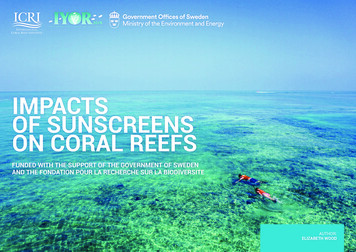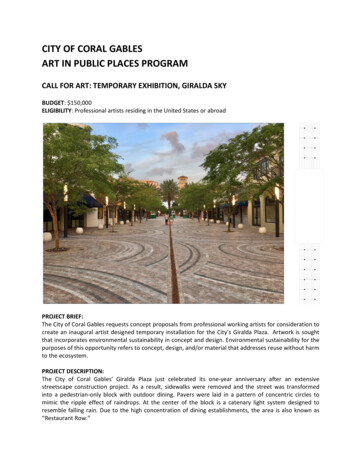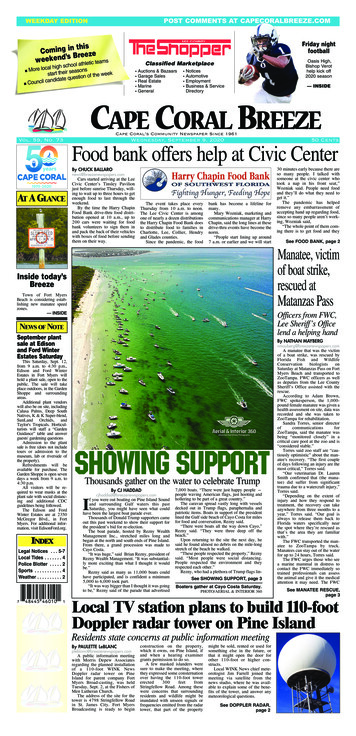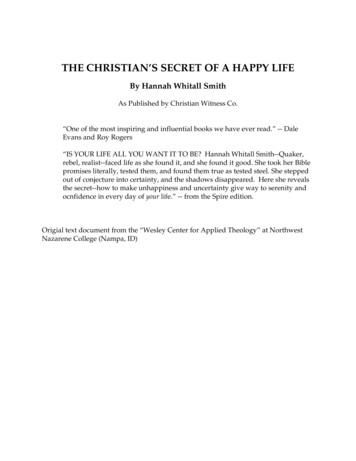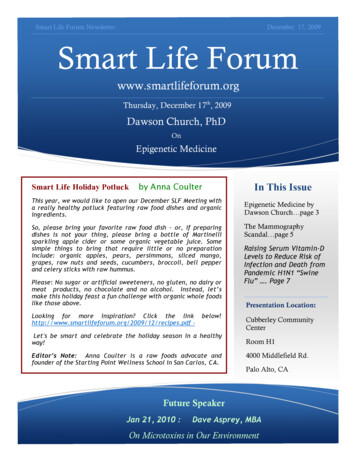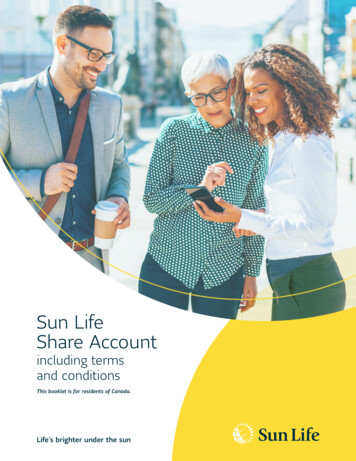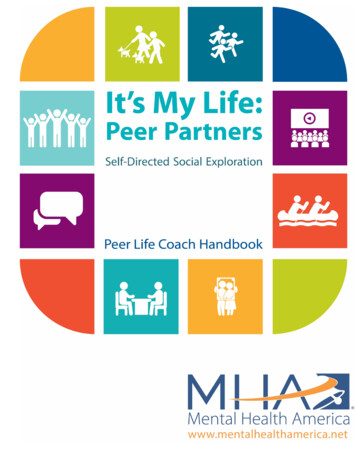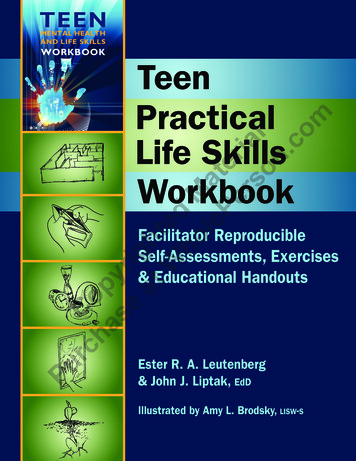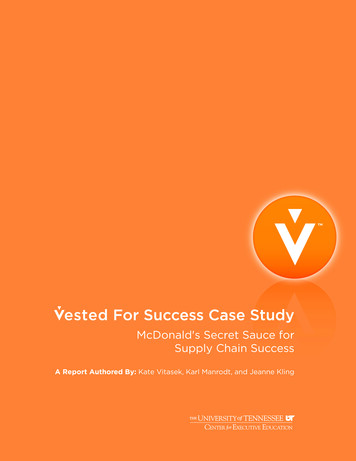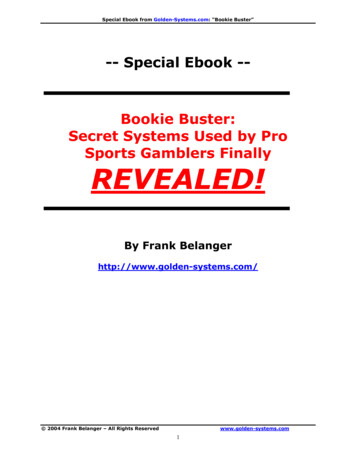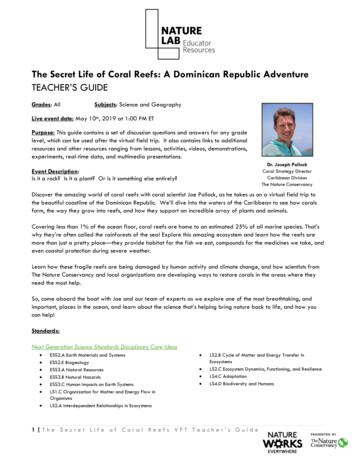
Transcription
The Secret Life of Coral Reefs: A Dominican Republic AdventureTEACHER’S GUIDEGrades: AllSubjects: Science and GeographyLive event date: May 10th, 2019 at 1:00 PM ETPurpose: This guide contains a set of discussion questions and answers for any gradelevel, which can be used after the virtual field trip. It also contains links to additionalresources and other resources ranging from lessons, activities, videos, demonstrations,experiments, real-time data, and multimedia presentations.Dr. Joseph PollockCoral Strategy DirectorCaribbean DivisionThe Nature ConservancyEvent Description:Is it a rock? Is it a plant? Or is it something else entirely?Discover the amazing world of coral reefs with coral scientist Joe Pollock, as he takes us on a virtual field trip tothe beautiful coastline of the Dominican Republic. We’ll dive into the waters of the Caribbean to see how coralsform, the way they grow into reefs, and how they support an incredible array of plants and animals.Covering less than 1% of the ocean floor, coral reefs are home to an estimated 25% of all marine species. That’swhy they’re often called the rainforests of the sea! Explore this amazing ecosystem and learn how the reefs aremore than just a pretty place—they provide habitat for the fish we eat, compounds for the medicines we take, andeven coastal protection during severe weather.Learn how these fragile reefs are being damaged by human activity and climate change, and how scientists fromThe Nature Conservancy and local organizations are developing ways to restore corals in the areas where theyneed the most help.So, come aboard the boat with Joe and our team of experts as we explore one of the most breathtaking, andimportant, places in the ocean, and learn about the science that’s helping bring nature back to life, and how youcan help!Standards:Next Generation Science Standards Disciplinary Core Ideas ESS2.A Earth Materials and SystemsESS2.E BiogeologyESS3.A Natural ResourcesESS3.B Natural HazardsESS3.C Human Impacts on Earth SystemsLS1.C Organization for Matter and Energy Flow inOrganismsLS2.A Interdependent Relationships in Ecosystems LS2.B Cycle of Matter and Energy Transfer inEcosystemsLS2.C Ecosystem Dynamics, Functioning, and ResilienceLS4.C AdaptationLS4.D Biodiversity and Humans1 The Secret Life of Coral Reefs VFT Teacher’s Guide
National Geography Standards 4 - The physical and human characteristics of places8 - The characteristics and spatial distribution of ecosystems and biomes on Earth's surface11 - The patterns and networks of economic interdependence on Earth’s surface14 - How human actions modify the physical environment15 - How physical systems affect human systemsDiscussion Questions: You can use or adapt these questions for a follow-up discussion with your students afterviewing the virtual field trip.1. Where can you find coral reefs around the world?Answer: Coral reefs form in warmer waters near the equator and between the Tropic of Cancer and the Tropic ofCapricorn.2. What is coral?Answer: Coral is an animal that has a hard skeleton filled with soft, fleshy parts called polyps. The polyps arelike mini jellyfish that live together in a colony.3. What does symbiosis mean?Answer: Symbiosis is when two different organisms live close together and interact in some way. This interactioncan be positive or negative. A positive interaction is called “mutualism” because both organisms benefit.4. Give an example of mutualism in a coral ecosystem and explain how the symbiotic relationship works.Answer:a. Zooxanthellae (microalgae) and Corals: Zooxanthellae help corals by providing food for the coralsand corals help zooxanthellae by giving them a place to live. Corals also provide zooxanthellaewith carbon dioxide that they can use during photosynthesis.b. Herbivores and Corals: Some fish that are herbivores eat macroalgae that is growing in competitionwith the coral. Parrot fish are a great example of a fish that helps corals in this way.5. List and describe some of the things that coral reefs do for people.Answer:a. Coastal Protection: Reefs act as a barrier and help to calm or buffer waves that could be destructiveto property on the coasts. They help prevent the coastline from eroding and keep waves fromsurging onto land and flooding property.b. Habitat for Fish: Reefs provide a home for a wide variety of organisms, including fish that peopleeat and sell to make a living.c. Tourism: Reefs provide natural beauty to support a tourist-based economy that benefits when peoplecome to dive and snorkel.6. In what ways are coral reefs sensitive?Answer: Coral reefs are sensitive to temperature change. Reef-forming corals live in waters that are not too hotand not too cold. Slight increases in temperature can cause the corals to expel their zooxanthellae. This is calledcoral bleaching because the zooxanthellae give corals their color. When the zooxanthellae leave, the coralsappear white or bleached. If the water temperature cools, the zooxanthellae will come back, however, if thezooxanthellae leave for too long, the corals can die. Corals are also sensitive to pollution and overfishing.Lastly, ocean acidification, caused by the increased uptake of carbon dioxide in the ocean, can greatly diminishthe ability of corals to build new structures and can even cause coral skeletons to weaken or dissolve.2 The Secret Life of Coral Reefs VFT Teachers’ Guide
7. What are some ways that people in the Dominican Republic have worked to save their reefs and protectocean habitats?Answer: Fishing for Parrot Fish has been banned so that these fish can continue helping coral by eating themacroalgae that competes with the corals. Fragmentation and microfragmentation techniques are helping toincrease and strengthen coral populations in vulnerable or degraded areas.8. What are some things that you can do to help coral reefs stay healthy and strong?Answer: You can be mindful of the fish that you eat and make sure to eat fish that are sustainably harvested byusing websites like NOAA’s Fishwatch (www.fishwatch.gov) to learn which species are okay to eat. Don’tpurchase jewelry made with coral pieces. If you go snorkeling or diving near reefs, don’t touch the corals and becareful not to step on them or hit them with your feet. Don’t litter – it might eventually end up in our oceans.Conserve water – the less wastewater you generate, the less likely that wastewater will end up in the ocean. Teachother people what you have learned about corals.Related Resources: The following lesson plans and videos can be used to supplement the virtual field trip.The Need is Mutual: The Importance of BiologicalInteractionsGrade Levels: 6-8Organisms have a variety of relationships. In this lesson, studentslearn to categorize relationships, like symbiosis, between organisms.To reinforce the lesson, examples from coral reefs are presented.There are several extensions for this lesson plan. Ian Shive/TNCThe Coral Reefs of Palau: Nature’s AmazingUnderwater CitiesGrade Levels: 3-8 Ian Shive/TNCJoin scientist Stephanie Wear on a virtual field trip to the coral reefsof Palau where you'll explore amazing underwater cities found neara remote network of islands in the Pacific Ocean. Our journey to thecoral reefs will open your eyes to an amazing, interconnectedecosystem built on symbiosis, where diverse organisms are designedto protect, clean, nourish, and even camouflage one another. In thisnatural factory, the coral supports its many “workers” and they, inturn, keep the coral healthy.3 The Secret Life of Coral Reefs VFT Teacher’s Guide
Other Related ResourcesClassroom Resources (All Grades) Students Rebuild Ocean Challenge – Create ocean-related artwork and support ocean conservation and allenges/oceanNOAA Education Coral Ecosystems Collection – Background information, lessons and activities, reef-ecosystemsNOAA Education Ocean Acidification Collection – Background information, lessons and activities, -acidificationNOAA Coral Reef – 3D Printed Coral Polyp el.htmlGoogle Earth Great Barrier Reef Street View – Explore coral reefs using -scenes/streetview/treks/oceans/Google Earth Underwater Street View for World Oceans Day lore-life-beneath-waves-in-honor-of.htmlVideos (Middle School to High School Level) Science Bulletins – Coral Reefs in Hot Waterhttps://www.youtube.com/watch?v RTcBFME4 bU&list PL03468DEB0456E448&index 21NOAA’s Ocean Today Every Full Moon Coral Under Threat Video nderthreat/Real-time Data (Middle School to High School Level) Data in the Classroom – Ocean Acidification and Coral Bleaching Moduleshttp://dataintheclassroom.noaa.gov/NOAA View Data Exploration Tool – Find data sets on ocean temperature, coral locations, coral .htmlOcean Acidification Activities and ExperimentsBelow is a summary of a few demonstrations or simple experiments you can do with students. The URLs provided come fromlesson plans with more detailed information. Use beakers with differing concentrations of acid (in this case – vinegar). Put calcium tablets, old-style chalk, egg shells,etc. in the beakers and watch the change over time. The pH of the solution can be measured, and the items can beweighed as time passes. This demonstrates how organisms with calcium carbonate shells can dissolve in the presence ofincreased acidity.o sWorkshopPage/Hands on acivities/Marine Osteoporosis/marineos.pdfo s-WorkshopPage/Hands on acivities/OA Shells.pdf Put red cabbage juice or bromothymol blue indicators in a beaker and blow into them with straw (adding CO2). Theindicator will change color as CO2 increases. This demonstrates how the ocean takes up carbon dioxide.o http://monitor.noaa.gov/education/pdfs/rov ocean acidification.pdf Put dry ice in a beaker with bromothymol blue. As the dry ice sublimates, the carbon dioxide gas will change the colorof the indicator from blue to green to yellow. This illustrates how carbon dioxide can be taken up by seawater.4 The Secret Life of Coral Reefs VFT Teacher’s Guide
5 The Secret Life of Coral Reefs VFT Teachers’ Guide
The Secret Life of Corals Virtual Field Trip LogBEFOREAFTERI know that I want to know more about I wonder if My favorite part was I hope that I learned that Imagine you are in the Dominican Republic – what would you bedoing? Are you on a boat, snorkeling, diving, or relaxing on thebeach? On the left, draw a “selfie” of yourself on your trip.Rate this virtual field trip by coloring in the number of stars youwould give it!6 The Secret Life of Coral Reefs VFT Teacher’s Guide
1 The Secret Life of Coral Reefs VFT Teacher’s Guide The Secret Life of Coral Reefs: A Dominican Republic Adventure TEACHER’S GUIDE Grades: All Subjects: Science and Geography Live event date: May 10th, 2019 at 1:00 PM ET Purpose: This guide contains a set of discussion questions and answers for any
